
Find definitions for general metal detecting terms that you may come across when you are reading about our product features and technologies.
If you want to know more about Minelab's product-specific technologies, visit the KeyTechnologies page.
Alkaline batteries are non-rechargeable batteries. They are available in common battery sizes such as AA, C & D and have a voltage of 1.5 volts per cell. These are the most commonly available battery.
All metal refers to operating a metal detector without any metals being masked or discriminated. All metals will be detected regardless of ferrous or conductive properties.
An Amplifier is a device or electronic circuit that increases amplitude (strength) of an electrical signal. The signal can be either an audio signal (sound) or a radio signal (electromagnetic).
Analogue refers to a method of transmitting and receiving data between electronic devices or within an electronic circuit. Analogue signals contain information in their amplitude (i.e. 2.83 volts) at a point in time or over a period of time. (Also see “Digital”)

Auto tune is a metal detector feature that shifts the detector’s operating channel to reduce the effect of environmental noise. If an environmental noise source is operating at, or producing, harmonic frequencies that match the detector’s operating channel the detector becomes susceptible to falsing. By shifting the detector’s operating channel up or down the detector can avoid being affected by environmental noise. (Also see “Noise Cancel”)
CO is an abbreviation that refers to conductivity on the Smartfind display found on the Explorer SE and E-TRAC.
A Concentric coil has an inner circle and an outer circle wire winding. The search pattern is cone shaped and can be useful for accurately pinpointing targets. Concentric coils require more sweep overlap for thorough ground coverage. They are also noisier in highly mineralised ground and therefore might not be the best choice for gold prospecting.
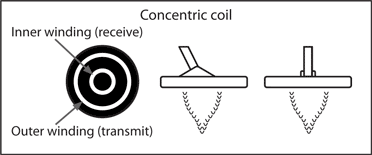
Conductivity refers to how well a target allows electrical current to flow through it. In other words a highly conductive target has low electrical resistance and therefore allows current to flow more easily. Conversely a target with low conductivity has high electrical resistance and does not allow current to flow easily. (Also see ”Time constant”)
Continuous wave is a type of metal detecting technology. Continuous wave metal detectors create an electromagnetic field that is applied to the ground in a continuous sine wave.
The control box encloses the electronic circuitry of the detector, that generates the Tx (transmit) signals sent by the search coil and processes the Rx (receive) signals detected by the search coil.
Current is the flow of electrical charge and is measured in Amperes (A or Amps). Current measurements are common on batteries and power supplies (i.e. AA NiMH battery: 2600 mAh, DC power supply: 1.5 A). Current is also induced into targets by the electromagnetic field produced by metal detectors, these are called eddy currents. (Also see “Voltage”)
Depth in metal detecting terms refers to how deep a target is buried. A metal detector that can achieve greater depth is able to detect deep targets. Minelab’s E-TRAC, X-TERRA and Explorer SE also have graphical depth indicators.
A detectorist is a person who regularly uses metal detectors professionally or as a hobby.
Digital refers to a method of transmitting and receiving data between electronic devises or within an electronic circuit. Digital signals (or data) use only two states, high or low and generally conform to a counting method called binary. Electronic circuits that process digital signals have many advantages over analogue circuits, including; less susceptible to noise and interference, able to process more information, able to filter signals using less electronic components, are lighter and cheaper.

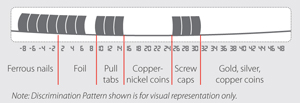
Discrimination is a metal detector’s ability to identify buried targets based onconductive and/or ferrous properties. By accurately identifying a buried target you can decide to dig it up or consider it as junk and continue searching. Minelab detectors produce target identification (Target ID) numbers and/or Target Tones to indicate the type of target that has been detected.
There are four main types of discrimination in Minelab detectors:
A Discrimination pattern is a graphical representation of accepted and rejected targets based on ferrous and conductive properties. Targets with properties that appear in the shaded section are masked and targets with properties that appear in the non-shaded area are accepted. Discrimination patterns are used on Minelab’s X-TERRA series (one dimensional) as well as Explorer and E-TRAC with the two dimensional Smartfind discrimination display. (Also see “Discrimination”)
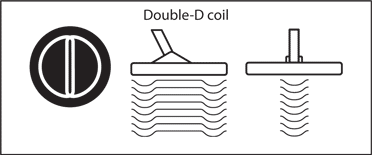
A Double-D coil has two overlapping wire windings in the shape of two D’s. The benefits of a Double-D coil are stability (especially in heavily mineralised ground), good depth, sensitivity and a very thorough search pattern requiring less overlap.
When used with GPX detectors, Double-D coils (unlike Monoloop coils) are able to discriminate between ferrous and non-ferrous targets when Iron Reject is activated. They are also more stable when used on wet salt beach sand and in electrically noisy environments.
When used with X-TERRA detectors, Double-D coils perform quieter than Concentric coils in mineralised ground and are therefore well suited for gold prospecting.
Eddy currents are tiny electrical currents that are induced into targets when a metal detector’s electromagnetic field is present. These eddy currents then generate an electromagnetic field around the target which can be detected by a metal detector.
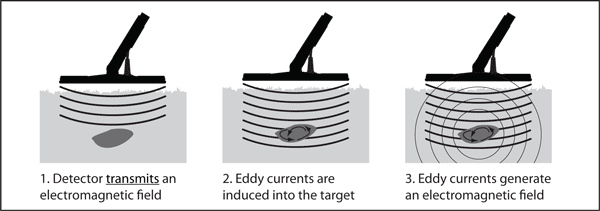
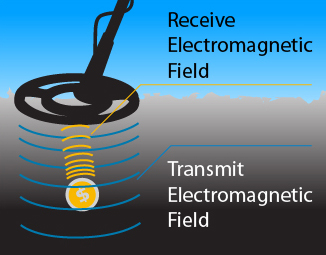
An electromagnetic field is a physical field produced by electrically charged metal objects. This refers to both the transmit field from the detector’s search coiland the receive field from a target. The electromagnetic field illustration shows the transmit field from the coil in blue and the receive field from the target in yellow.
Environmental noise comes from power lines, underground cables, radar, other detectors or climatic conditions like thunder storms that produce electrical signals or noise that can interfere with a metal detector’s operation.
Falsing occurs when a metal detector gives a detection response to electrical noise, ground noise or bumping.
FE is an abbreviation that refers to a target’s ferrous properties on the Smartfind display found on the Explorer SE Pro and E-TRAC.
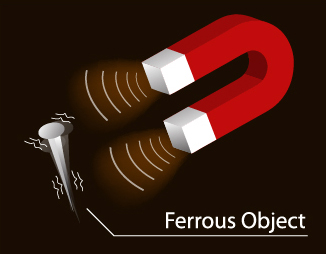
Ferrous objects/targets contain iron and therefore are attracted to a magnet, e.g. horse shoes, nails, tin cans. The ferrous illustration shows a ferrous nail being attracted to a magnet. Many natural and man-made objects contain iron, most of these are junk targets, however some can be valuable relics.
The frequency of a metal detector is one of the main characteristics that determines how well targets can be detected. Generally, a single frequency detector that transmits at a high frequency will be more sensitive to small targets and a single frequency detector that transmits at low frequencies will give more depth on large targets. Minelab’s single frequency technologies are VLF and VFLEX. Minelab’s revolutionary BBS, FBS and MPS technologies transmit multiple frequencies and are therefore simultaneously sensitive to small and deep large targets.
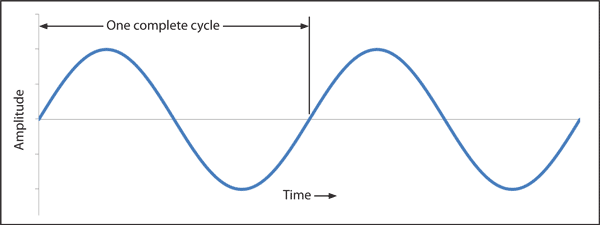
For example if a signal repeats itself 10 times every second the signal’s frequency is 10 Hz.
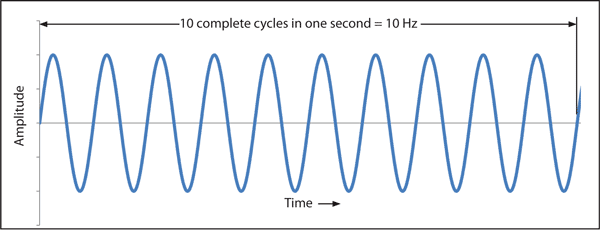
The frequency that a metal detector operates at (transmitted by the search coil) affects its performance, as a rule of thumb, the lower the frequency, the deeper it can penetrate the ground. At low frequencies however, sensitivity to small low conductive targets is reduced. The higher the frequency, the higher the sensitivity to small targets, but will not penetrate as deeply.
In general, gold detectors operate at higher frequencies (to find small nuggets), while coin and treasure detectors work at lower frequencies for deeper penetration. The exception to this is MPS type metal detectors that are sensitive and deep seeking simultaneously.
Frequency domain refers to the viewing or analysis of signals with reference to frequency, rather than time. (Also see “Time domain”)
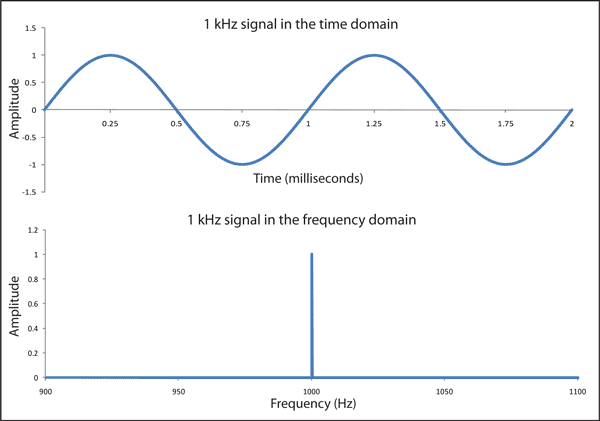
Gold prospecting is the activity of searching for new gold. Gold prospecting metal detectors have different performance characteristics to Coin, jewellery & relic hunting metal detectors. Gold prospecting metal detectors have superior ground balancing abilities to operate in highly mineralised ground and can detect targets at greater depth.
Ground Balance is a variable setting that increases detection depth in mineralised ground. This ground may contain salts, such as in wet beach sand or fine iron particles, such as in red earth. These minerals respond to a detector’s transmit field in a similar way that a target does. Due to the much larger mass of the ground compared to a buried target, the effect of mineralisation can easily mask small targets. To correct this the Ground Balance setting removes the responding ground signals, so you clearly hear target signals and are not distracted by ground noise.
There are three main types of Ground Balance:
Minelab detectors use exclusive advanced technologies for superior ground balancing capabilities that cannot be matched by any other detectors.
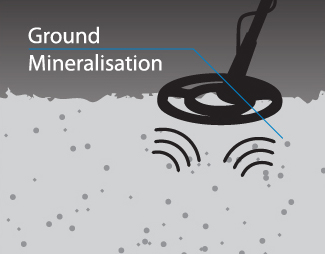
Ground Mineralisation refers to the naturally occurring minerals in the ground that affect a metal detector’s performance. There are two main types of ground mineralisation, one is due to iron particles and can be identified by its red colouration. The other is due to salt, such as salt water beaches. Iron particle mineralisation causes the ground to become magnetic and salt mineralisation causes the ground to become conductive. Both forms of ground mineralisation can produce false signals that mask targets. The ground mineralisation illustration shows minerals in the ground producing a response to the metal detector’s electromagnetic field.
Ground noise is the false signalling caused by a metal detector that is not ground balanced to the soil. The ground noise occurs when the unbalanced detector’s search coil is swept across ground that varies in mineralisation, soil type, rocks or has dips and holes.
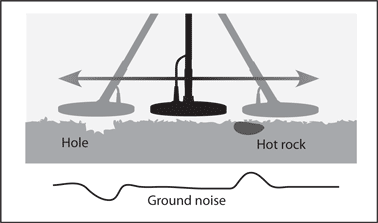
Ground tracking refers to the ability of the detector to track changes in ground mineralisation and automatically adjust the ground balance to suit. This ensures perfect ground balance and full detection depth, eliminating the need for the operator to stop and manually adjust the detector as ground conditions change.
Halo effect occurs after a target has remained undisturbed in the ground for a considerable amount of time. As the target breaks down or rusts the soil immediately around it becomes highly mineralised. A detector will see this area of high mineralisation and give a detection response indicating that the target is larger than it really is.
Harmonic frequencies are components of a signal or wave that are multiples of the fundamental frequency. For example a 15 kHz signal will have harmonic frequencies at 30 kHz, 45 kHz, 60 kHz, 75 kHz and so on. These harmonic frequencies reduce in magnitude as they get further and further away from the fundamental frequency of 15 kHz. Harmonic frequencies are best viewed in the frequency domain.
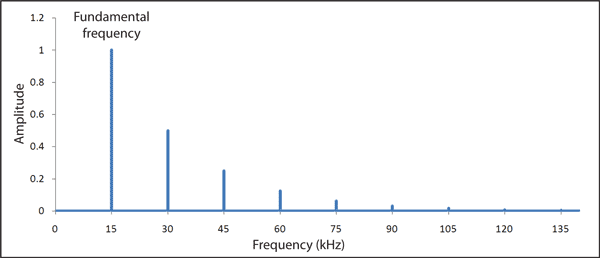
Hot rocks are rocks that are mineralised differently to their surrounding ground. For example a highly mineralised rock buried in mildly mineralised ground would be considered to be a hot rock. However, a highly mineralised rock in an equally highly mineralised ground would not be considered to be a hot rock. (Also see "Ground mineralisation")

Iron mask refers to operating a metal detector with iron masked or discriminated. Only non-ferrous metals containing little or no iron will be detected.
Junk (or trash) refers to unwanted ferrous or non-ferrous metal targets. Nails, paperclips and wire are examples of ferrous junk and bottle tops, ring pulls and foil are examples of non-ferrous junk. Junk is often buried amongst valuable targets like coins. To solve this, Minelab has a range of metal detectors with the ability to ‘ discriminate’ whether a target is likely to be treasure or trash based on both ferrous and conductive properties.
Lithium-ion batteries are a type of rechargeable battery that has advantages over older rechargeable battery technologies like nickel-metal hydride (NiMH), nickel cadmium (NiCd) and sealed lead acid (SLA). Lithium-ion batteries are lighter, have no memory effect and a low self discharge rate.
Monoloop coils are a special style of coil for MPS technology detectors (SD & GPX Series). These coils have one winding of wire around the circumference of the coil, which is used to both transmit and receive. The signal pattern of the Monoloop coil is cone shaped, requiring more overlapping. In extremely heavily mineralised grounds they can be more difficult to ground balance, however they tend to provide slightly better depth than the Double-D coils.
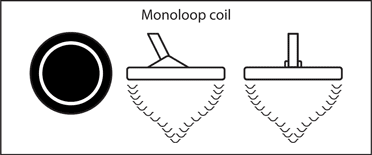
Multi-frequency is a type of metal detector technology that uses more than one frequency. Single frequency metal detectors can be limited due to their fixed frequency. This is because lower frequencies detect deeper into the ground, but higher frequencies detect smaller targets. By combining multiple frequencies into one detector, depth and sensitivity to small targets is achieved. (Also see “Broad Band Spectrum (BBS)” & “Full Band Spectrum (FBS)”)
Nickel cadmium batteries are rechargeable batteries. They are available in common battery sizes such as AA, C, and D, however at 1.2 volts they have a slightly lower cell voltage than alkaline and carbon zinc batteries. NiCds have high discharge current capabilities due to their low internal resistance, but suffer from memory effect and have a relatively high self discharge rate (will discharge themselves over about ten weeks).
Nickel metal hydride batteries are rechargeable batteries, which have advantages over NiCd batteries. NiMH provide 1.2 volts per cell, but do not suffer from a memory effect and are capable of higher energy densities than NiCd batteries.
Noise Cancel is a metal detector feature that shifts a metal detector’s operating frequency or frequencies to reduce the effect of environmental electromagnetic noise, from sources such as power lines, cell phone towers and other metal detectors. (Also see “Auto tune”)
Non-ferrous materials do not contain iron. Good targets include coins, gold rings and copper artefacts. Junk targets include bottle tops, pull tabs, and aluminium foil. (Also see "Ferrous")
Notch filter discrimination discriminates a narrow group of metal objects based on their conductive and ferrous properties.
Ohm is a unit of measure of electrical resistance (symbol Ω). Resistance measurements are common on headphones and speakers. (Also see “Voltage” & “Current”)
Period is the time it takes for a wave or signal to complete one cycle. The period is also the inverse of the wave’s frequency. (i.e. period = 1/frequency)
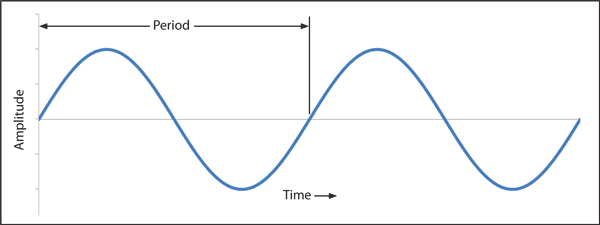
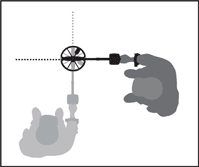
Pinpointing is the activity of narrowing down the location of a buried target. Many of Minelab’s detectors have a pinpointing mode that allows the user to determine the exact location of a target before digging. The process involves putting the detector into pinpoint mode and slowly sweeping the ground above the target to find the strongest response, then turning 90º and sweeping again to get an accurate target location.
Pulse Induction (PI) is a type of metal detecting technology. Pulse induction operates by sending short pulses of voltage to the metal detectors coil. These short pulses cause a magnetic field to be generated which quickly dissipates at the end of each pulse. Any metal targets that induce the magnetic field remain magnetised for a short time after the end of a pulse. The target’s decaying magnetism is then detected by the detector’s coil. (Also see “Multi period sensing (MPS)” & “Dual Voltage Technology (DVT)”)
QuickMask is a feature available on Minelab’s E-TRAC. QuickMask allows a user to quickly edit and customise a discrimination pattern.
Receive is the process of collecting a signal or magnetic field by the metal detector’s search coil.
Resistance is the opposition to current flowing in an electrical conductor and is measured in Ohms(Ω).
Sealed lead acid batteries are rechargeable batteries. They come in a wide variety of sizes and are most often packaged in 6 volt or 12 volt packs. SLA batteries have high discharge current capabilities due to their low internal resistance.
The search coil is the circular or elliptical plate that is swept above the ground during detecting. It transmits electromagnetic signals into the ground and receives the response. The word coil actually refers to the wire windings inside the housing, which can take different forms and shapes. For more information on the different types of coils see Concentric coil, Double-D coil and Monoloop coil.
Sensitivity refers to how responsive a metal detector is to small or deep targets.
Signal in metal detecting terms refers to both the transmitted magnetic field from the detectors search coil and the received magnetic field from a metal target.
A square wave is the name given to a waveform that has rapid transitions from one state to another. Square waves are used in electronics as clock signals, timing pulses and control signals. Square waves generate many harmonic frequencies.

Target refers to any metal object that can be detected by a metal detector. A target can be either valuable, such as a coin or junk, such as a bottle top.
Target ID numbers and audio tones are produced by a metal detector to enable you to identify targets based on their conductive and/or ferrous properties.
| Target | Target ID |
| US Quarter | 44 |
| Australian $1 coin | 32 |
| Ring pull | 12 |
| Wedding ring | 8 |
| Long screw | -4 |
| Short screw | -4 |
| Paper clip | -4 |
Threshold is the continuous sound used to listen for target signals. The Threshold will ‘blank’ to indicate the detection of a discriminated/rejected target.
Time constant is a measure of a target’s combined conductivity and inductance. A target with high conductivity (low resistance) and high inductance will have a long time constant (i.e. gold ingot). A target with low conductivity (high resistance) and low inductance will have a short time constant (i.e. fine jewellery). Minelab metal detectors are capable of detecting the full range of time constants.
Time domain refers to the viewing or analysis of signals with reference to time, rather than frequency. (Also see “Frequency domain.”)

Timings refer to the digital switching rates that control the internal electronics of the detector. In the GPX series of detectors the timings generate a pulse train to create the transmit waveform. The same timings generate synchronised switching signals to control the receive electronics.
Selecting different timings and thus changing both the transmit waveform and synchronised receive switching signals have benefits for different ground types and targets. Minelab has created a range of different timings in the GPX series of detectors that achieve optimum depth, sensitivity and ground balancing across different detecting conditions. (Also see “Multi period sensing (MPS)”, “Dual Voltage Technology (DVT)” & “SETA”)
Tone identification is similar to target ID numbers; however, instead of using displayed numbers different tones are associated to different target IDs.
Transmit is the process of sending a signal or magnetic field from the metal detector’s search coil.
Trashy ground is ground that has high levels of junk.
A Universal Serial Bus is a type of computer data port. Minelab’s E-TRAC has a USB port that enables it to communicate with a PC to upload and download settings and discrimination patterns.
VLF is a type of metal detecting technology. VLF metal detectors create an electromagnetic field that is applied to the ground in a continuous sine wave.
Voltage is electrical potential and is measured in volts (symbol v). Voltage measurements are common on batteries and power supplies (i.e. AA NiMH battery: 1.2 v, DC power supply: 12v). Voltage is used to energise a metal detector’s search coil, which in turn generates the electromagnetic field. (See also “Current” & “Resistance”)